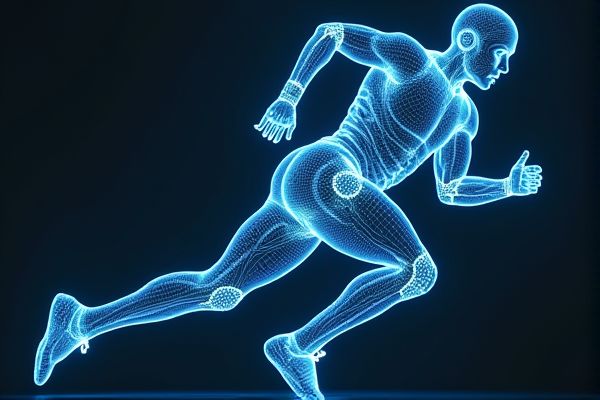
AI enhances athletic training by providing personalized workout plans that adapt to an athlete's performance metrics. Real-time data analysis through wearable technology allows trainers to monitor heart rates, movement efficiency, and recovery times effectively. Predictive analytics help in injury prevention by identifying patterns that may indicate a higher risk based on an athlete's training load. Virtual coaching platforms leverage AI to deliver feedback and training recommendations, ensuring optimal performance while maintaining athlete well-being.
AI usage in athletic training regimes
Performance Data Analysis
AI can significantly enhance athletic training regimes by analyzing performance data to identify strengths and weaknesses. For example, utilizing AI algorithms at institutions like the Olympic Training Center can refine training strategies for athletes. This technology provides personalized insights that can lead to improved performance outcomes. The possibility of optimizing training schedules through data-driven decisions presents a considerable advantage for athletes aiming for peak performance.
Personalized Training Plans
AI can create personalized training plans by analyzing an athlete's performance data, enhancing efficiency in training. It allows coaches to adapt exercises based on real-time feedback, increasing the chance of improved performance. Institutions like the National Strength and Conditioning Association are exploring AI's potential in optimizing training strategies. The possibility of injury prediction through data analysis offers a significant advantage in keeping athletes healthy and performing at their best.
Injury Prediction and Prevention
AI can analyze vast amounts of data from athletes to identify patterns that may indicate a higher risk of injury. By leveraging machine learning algorithms, trainers can tailor training programs more effectively, enhancing performance while minimizing injury risk. For instance, predictive analytics in sports like football can assess player workloads, suggesting optimal rest periods to reduce strain. This capability presents a significant advantage for institutions such as professional sports teams, leading to better athlete management and potentially extending careers.
Real-Time Feedback
AI can enhance athletic training by providing real-time feedback to athletes, allowing for immediate adjustments in technique and performance. For example, AI-driven wearables can analyze an athlete's movements and suggest improvements to optimize efficiency. This technology increases the chances of injury prevention through timely insights, making training safer. Utilizing AI in institutions like elite sports academies could give athletes a competitive edge in their development.
Recovery Optimization
AI in athletic training regimes presents the possibility of personalized recovery optimization strategies. Athletes could benefit from tailored insights and predictions, allowing for more effective rest periods and training adjustments. For instance, institutions like the University of Michigan are exploring AI to enhance athlete performance through data-driven recovery protocols. The integration of AI could significantly reduce injury risks and improve overall training effectiveness.
Biomechanics Assessment
AI can enhance athletic training regimes through personalized feedback based on individual biomechanics assessments. By analyzing data from sensors and wearable devices, athletes can receive insights tailored to their specific movement patterns. Institutions like the National Institute of Sports Science are exploring these technologies to improve performance and prevent injuries. This integration presents opportunities for athletes to optimize their training efficiency and overall performance.
Nutritional Recommendations
AI can analyze an athlete's performance data to tailor training regimes that maximize efficiency and effectiveness. For instance, a marathon runner could benefit from customized nutritional recommendations based on their unique metabolism and training intensity. This technology can help identify optimal recovery strategies and injury prevention measures as well. By integrating AI into their routines, athletes have a greater chance of enhancing their overall performance and achieving their goals.
Mental Training and Focus Enhancement
AI can analyze athletes' performance data to identify strengths and weaknesses, potentially enhancing their training regimes. By incorporating mental training exercises tailored to individual needs, athletes may experience improved focus and reduced anxiety. The integration of AI in this context offers the chance to optimize preparation, as seen in programs like those used by the U.S. Olympic and Paralympic Committee. This technology might provide real-time feedback that helps athletes refine both physical and mental aspects of their training.
Wearable Technology Integration
AI can significantly enhance athletic training regimes by analyzing performance data and suggesting personalized training plans. Wearable technology, such as smartwatches or fitness trackers, can provide real-time feedback on an athlete's metrics, improving focus on key areas. This integration allows coaches to make data-driven decisions to optimize performance and reduce injury risks. For example, institutions like the National Football League (NFL) are increasingly utilizing AI and wearables to refine training approaches and enhance player safety.
Talent Identification and Development
AI can enhance athletic training regimes by analyzing performance data to tailor individualized training plans. For example, institutions like the United States Olympic & Paralympic Committee are exploring AI tools to improve talent identification through predictive analytics. These technologies can uncover potential in athletes that might be overlooked using traditional methods. The chance of developing elite athletes increases significantly when data-driven insights guide training and development efforts.
 techknowy.com
techknowy.com